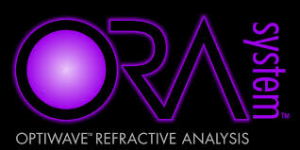On this page we will describe major advances in cataract treatment as well as treatment options that may be helpful. Understanding treatment options before your elective cataract surgery is an important step in preparing for your state-of-the-art cataract surgery.
Intraocular Lens Options
At the time of your cataract surgery a new lens is implanted once your cloudy lens is removed. There are two main types of premium lenses that are available to patients: Astigmatism reducing and Multifocal.
Multifocal Intraocular Lens
Multifocal lenses can be implanted at the time of your cataract surgery. These PanOptix lenses from Alcon have a multifocal effect which can increase your range of focus after cataract surgery and reduce your dependence on glasses or eliminate the need entirely.
Multifocal lenses have surface modifications on them which allow distant and near objects to be focused simultaneously. This is in contrast to the standard monofocal lens where only one distance is in focus. There are other factors to consider, and these would be discussed at the time of your cataract consultation.
 Source: Alcon Inc., FDA Summary of Safety and Effectiveness Data, Table 22; 2019
Source: Alcon Inc., FDA Summary of Safety and Effectiveness Data, Table 22; 2019
Astigmatism-reducing Intraocular Lens
These premium lenses can be implanted at the time of your cataract surgery to correct astigmatism. Using these special lenses, patients not only benefit from improved clarity after removal of the cataract, but also benefit from reduced astigmatism and reduced dependence on glasses.
What is ORA?
ORA is a laser-based system used during cataract surgery to measure the power of the lens to be placed in your eye.
During your cataract surgery the surgeon will be removing a cloudy lens. This blurry lens will be replaced with a clearer artificial lens called an intraocular lens. It is important that the power of this artificial lens be correctly matched for your individual eye so that you reduce the need for strong glasses after cataract surgery.
What is it?
ORA is a laser-based system used during cataract surgery to measure the power of the lens to be placed in your eye.
During your cataract surgery the surgeon will be removing a cloudy lens. This blurry lens will be replaced with a clearer artificial lens called an intraocular lens. It is important that the power of this artificial lens be correctly matched for your individual eye so that you reduce the need for strong glasses after cataract surgery.
How do eye doctors calculate the power of the artificial lens for your eye?
In the office, optical measurements will be taken through your cataract to estimate the power of the lens. While these laser-based measurements are better than previous ultrasound methods, they are less accurate in the setting of:
- A denser or cloudier cataract.
- Long or short eyes.
- Previous eye surgery, especially LASIK
Why use ORA?
In the operating room once the cataract has been removed, there is now a device called the ORA which lets us measure and refine the lens power that is suggested for your eye.
How does ORA work?
Unlike the measurements that were made during your pre-op visit in our office, the ORA measurments are made in the operating room once the cataract has been fully removed. This gives the ORA system the advantage of taking measurements without the interference of your cataract. ORA measures the reflected pattern of laser light that comes out of the eye while you are on the operating table and calculates the best lens power for your eye. It is also useful in aligning the position of Premium Toric astigmatism reducing lenses.
Who should use it?
Since the system is useful in refining our choice of lens power for your eye, it can be helpful in all cases, but it is most helpful in these situations:
1. Previous LASIK.
If you have had prior laser refractive surgery (LASIK) you should use the ORA system. Following LASIK, it is more difficult to calculate the lens power to implant during cataract surgery. You will reduce the chances of an incorrect lens power selection if you use ORA.
2. Toric intraocular lenses for astigmatism reduction.
These premium lenses need to be aligned as accurately as possible in the eye at the time of cataract surgery. The ORA measures the eye after implantation of your Toric lens and makes final alignment more precise since it is guided digitally.
3. Dense cataracts that make optical measurements difficult.
Sometimes a cataract has matured to the point where it disrupts the path of laser light into the eye, making office-based optical measurements less reliable. In these cases we may need to use ultrasound measurements to determine the length of the eye which, while state-of-the –art in the 1990s, are not as accurate as the optical methods preferred today.
4. Highly nearsighted patients or patients with strong glasses.
Measuring your eye for an intraocular lens can be less precise if you have high nearsightedness or farsightedness which is associated with a long or short eye. The ORA can improve the precision of our lens selection.
5. Multifocal lenses
6. Multifocal lenses function best when patients are in focus at distance after surgery. Improving the precision of lens power selection can improve the function of these multifocal lenses.
Routine cataract cases
Since current optical methods of measuring your intraocular lens have become more accurate, there is less of a need to use the ORA system for routine cataract cases. However, since it is a safe, non-invasive method it can serve as a useful check in the operating room if desired by the patient.
© Copyright Phillips Eye Center











